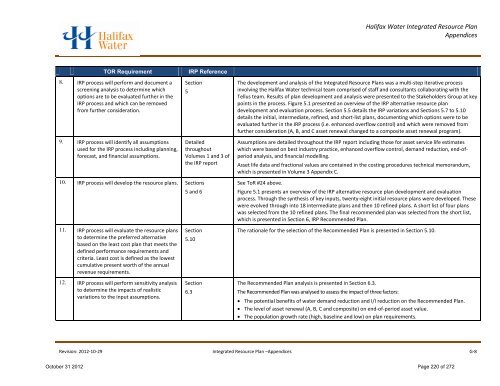volume 1 - Halifax Regional Municipality
volume 1 - Halifax Regional Municipality
volume 1 - Halifax Regional Municipality
You also want an ePaper? Increase the reach of your titles
YUMPU automatically turns print PDFs into web optimized ePapers that Google loves.
<strong>Halifax</strong> Water Integrated Resource Plan<br />
Appendices<br />
TOR Requirement<br />
8. IRP process will perform and document a<br />
screening analysis to determine which<br />
options are to be evaluated further in the<br />
IRP process and which can be removed<br />
from further consideration.<br />
9. IRP process will identify all assumptions<br />
used for the IRP process including planning,<br />
forecast, and financial assumptions.<br />
IRP Reference<br />
Section<br />
5<br />
Detailed<br />
throughout<br />
Volumes 1 and 3 of<br />
the IRP report<br />
The development and analysis of the Integrated Resource Plans was a multi-step iterative process<br />
involving the <strong>Halifax</strong> Water technical team comprised of staff and consultants collaborating with the<br />
Tellus team. Results of plan development and analysis were presented to the Stakeholders Group at key<br />
points in the process. Figure 5.1 presented an overview of the IRP alternative resource plan<br />
development and evaluation process. Section 5.5 details the IRP variations and Sections 5.7 to 5.10<br />
details the initial, intermediate, refined, and short-list plans, documenting which options were to be<br />
evaluated further in the IRP process (i.e. enhanced overflow control) and which were removed from<br />
further consideration (A, B, and C asset renewal changed to a composite asset renewal program).<br />
Assumptions are detailed throughout the IRP report including those for asset service life estimates<br />
which were based on best industry practice, enhanced overflow control, demand reduction, end-ofperiod<br />
analysis, and financial modelling.<br />
Asset life data and fractional values are contained in the costing procedures technical memorandum,<br />
which is presented in Volume 3 Appendix C.<br />
10. IRP process will develop the resource plans. Sections<br />
5 and 6<br />
See ToR #24 above.<br />
Figure 5.1 presents an overview of the IRP alternative resource plan development and evaluation<br />
process. Through the synthesis of key inputs, twenty-eight initial resource plans were developed. These<br />
were evolved through into 18 intermediate plans and then 10 refined plans. A short list of four plans<br />
was selected from the 10 refined plans. The final recommended plan was selected from the short list,<br />
which is presented in Section 6, IRP Recommended Plan.<br />
11. IRP process will evaluate the resource plans<br />
to determine the preferred alternative<br />
based on the least cost plan that meets the<br />
defined performance requirements and<br />
criteria. Least cost is defined as the lowest<br />
cumulative present worth of the annual<br />
revenue requirements.<br />
12. IRP process will perform sensitivity analysis<br />
to determine the impacts of realistic<br />
variations to the input assumptions.<br />
Section<br />
5.10<br />
Section<br />
6.3<br />
The rationale for the selection of the Recommended Plan is presented in Section 5.10.<br />
The Recommended Plan analysis is presented in Section 6.3.<br />
The Recommended Plan was analysed to assess the impact of three factors:<br />
• The potential benefits of water demand reduction and I/I reduction on the Recommended Plan.<br />
• The level of asset renewal (A, B, C and composite) on end-of-period asset value.<br />
• The population growth rate (high, baseline and low) on plan requirements.<br />
Revision: 2012-10-29 Integrated Resource Plan –Appendices G-8<br />
October 31 2012 Page 220 of 272
















